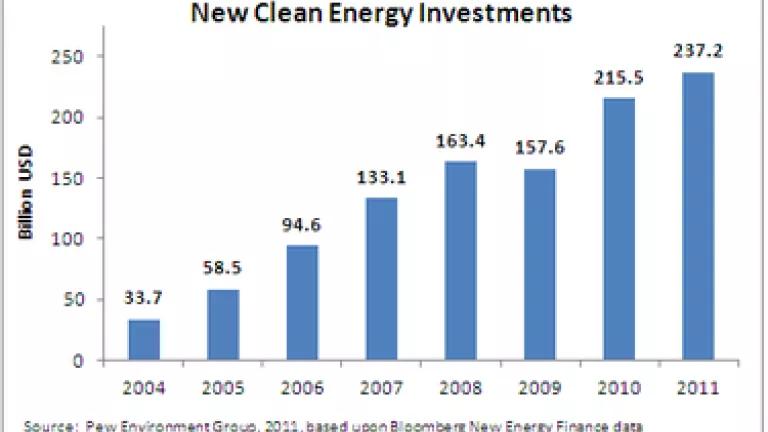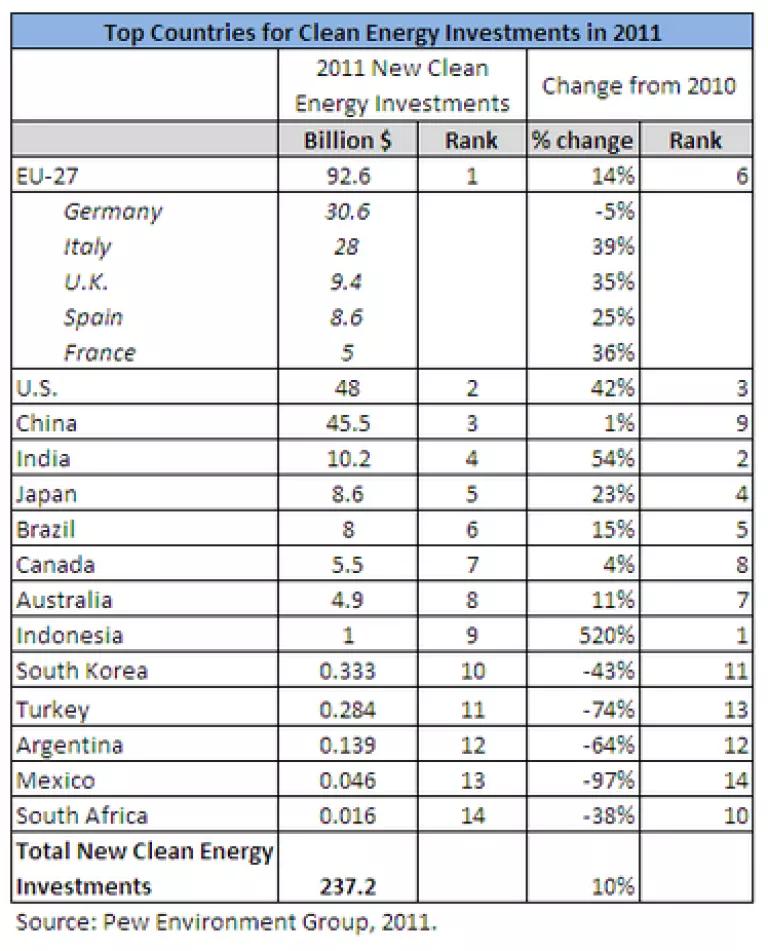Clean Energy Investments Continue to Soar: Time to "Triple Down" on Renewable Electricity

In 2011, new clean energy investments rose to a record $263 billion – a 6.5 percent increase from last year. The United States rose to the top in 2011 after having fallen behind China and Germany last year. But the 27 countries that make up the European Union (EU-27) as a whole were still head and shoulders above the rest. As countries go into the Rio+20 Earth Summit they should build upon this trend an commit to new policies and incentives to triple the amount of wind, solar, geothermal, and tidal power in their energy mix.
The findings of this new report –Who’s Winning the Clean Energy Race?—show that clean energy investments continue to increase, Europe is still a key investment hub, the U.S. has risen past China, and renewable electricity is continuing to surge. These are some of the key conclusions from the new report produced by the Pew Environment Group and Bloomberg New Energy Finance in their annual report which details the state of clean energy investments globally and where key countries stand as of the end of 2011.
Here are some key take-aways.
Clean energy investments continue to increase. New clean energy investments—minus research and development – rose to $237 billion in 2011. That would make it the 35th largest economy in the world if it were a country.** This is a 604 percent growth since 2004 and a modest 6.4 percent growth from 2010 (see figure). While growth slowed in 2011 it still outpaced the pace of economic growth across the entire world economy as clean energy continues to be a key economic sector. This shows that the clean energy economy is still a real opportunity to help create jobs and business opportunities, while at the same time reducing the global warming pollution caused by other sources of energy.
European Union had the most, followed by the U.S. and China. The 27 members of the European Union (EU-27) had almost twice the total investment—$92.6***— of the U.S. investment--$48 billion (see table). Investments in the U.S. surged by 45 percent from the previous year, while China’s investments slowed. China was just behind the U.S. with new investment of $45.5 billion, dropping below the U.S. for the first time in the past three years. At the same time, investments in India continue to dramatically increase – rising by 54 percent from 2010 levels. Out of the G20 countries, South Africa and Mexico are bringing up the rear.

Renewable energy continues to surge. Last year, a record amount of new renewable energy capacity was added to the electricity fleet throughout the world. According to the report, the EU-27 has the largest amount of installed renewable energy capacity at 199 GW, followed by the China at 133 GW and U.S. at 93 GW.
Solar energy was the largest recipient of new investments – accounting for more than half the clean energy investments in the G20 countries. This was due to an increased investment in solar coupled with a declining price of solar. As the report points out:
“The cost of wind and solar generating capacity is declining rapidly, with solar photovoltaic module prices dropping 50 percent in 2011 alone.”
Renewable energy is for real, so let’s commit to more. With the declining price of renewable energy – making it cost competitive in many situations – now is not the time to either pull back from these investments or continue to invest in dirty sources of energy. The belief that renewable energy is something that you do “because it is a nice thing to do”, doesn’t match reality. Renewable energy is real, cost competitive in many situations, and a growing source of business opportunity. And given that other sources of electricity contribute to global warming and local air pollution, now is the time to double-down on more renewable energy. [Better yet is to “triple down” by tripling the amount of renewable energy in the electricity mix as we’ve called for at Rio+20.]
Countries, companies, and citizens have a chance at the 2012 Earth Summit in Rio this June to triple down on renewable electricity. Will they come through?
-------------------------
* Figure: New Clean Energy Investments based upon data in Pew Environment Group, 2011. Data don’t include investments in research and development.
** GDP data is for 2010 from the World Bank.
*** The Pew Environment Group doesn’t include the data for the E.U. 27 as a whole, but this data has been compiled based upon adding together the EU countries where data is provided plus the category “other EU-27”.

